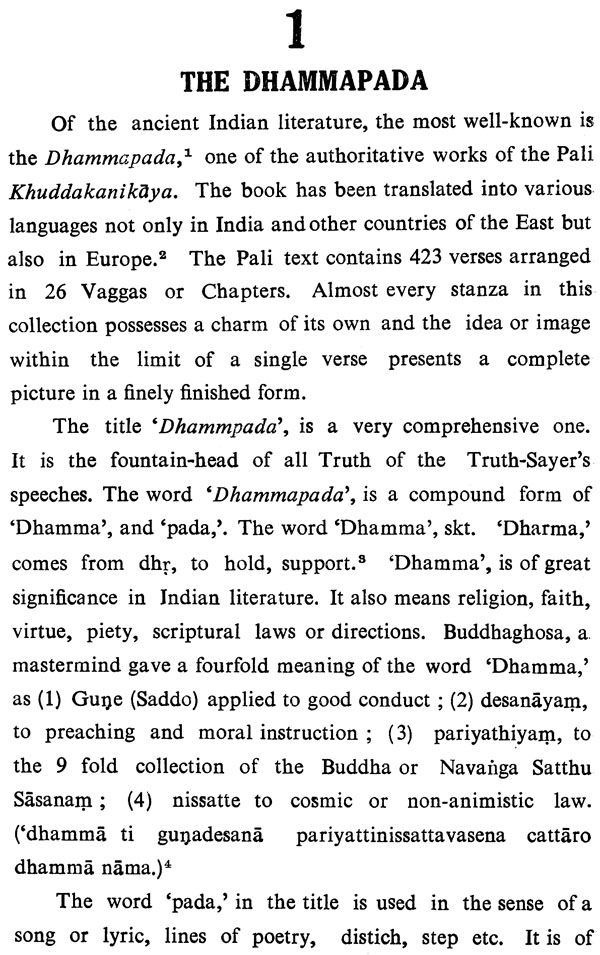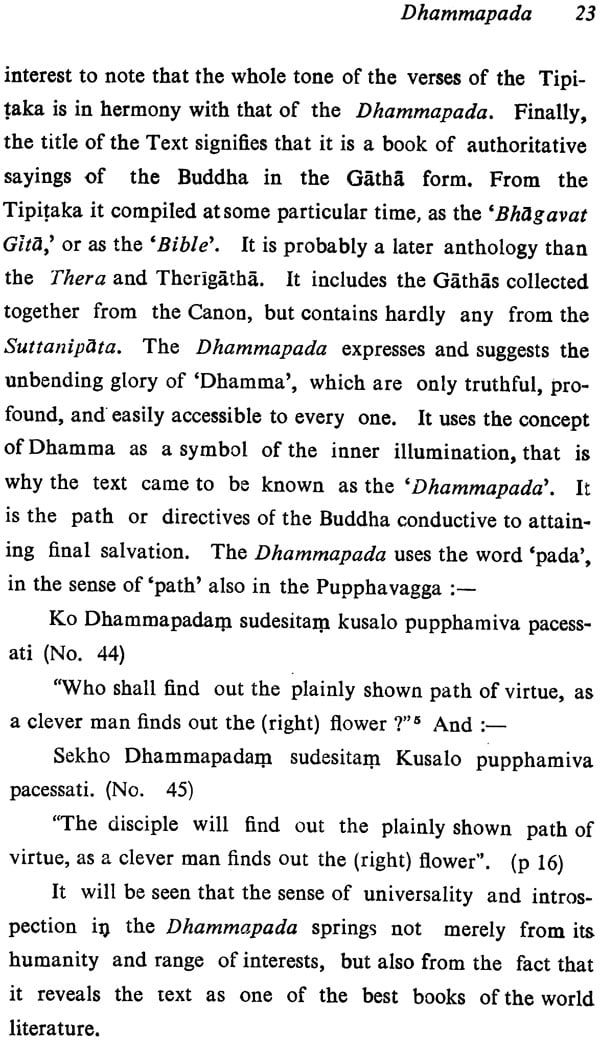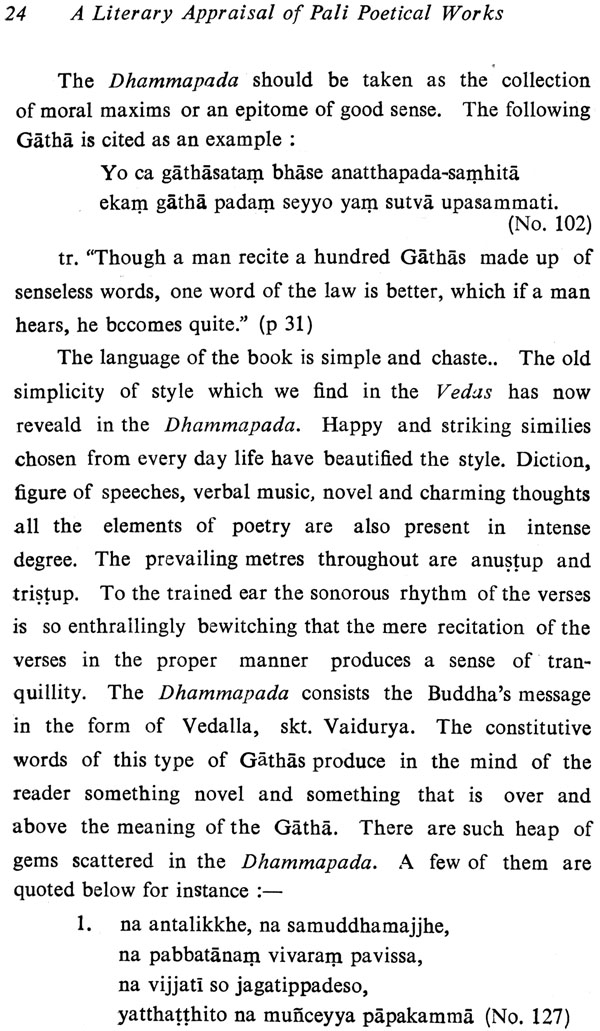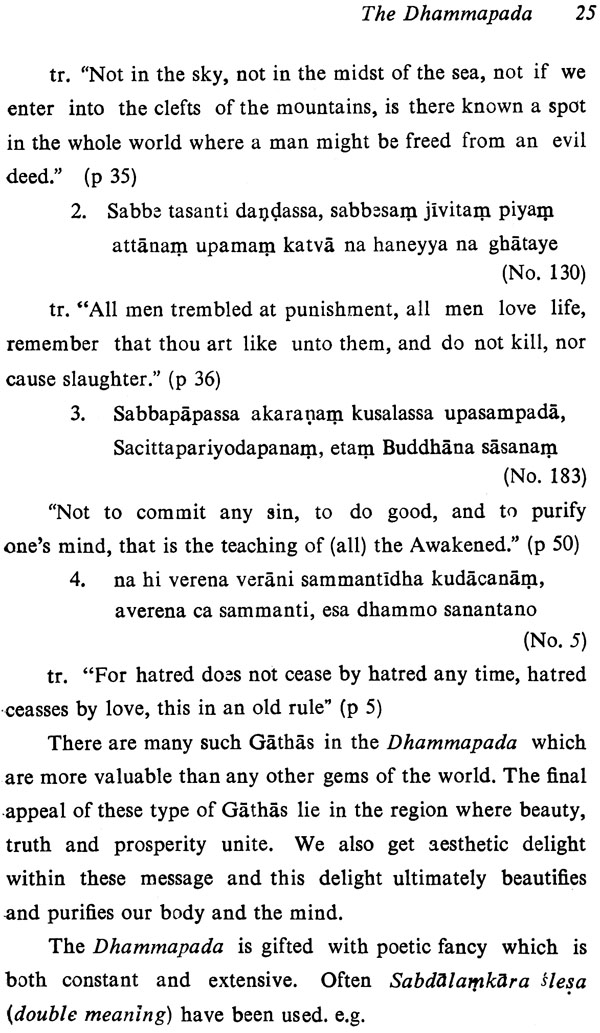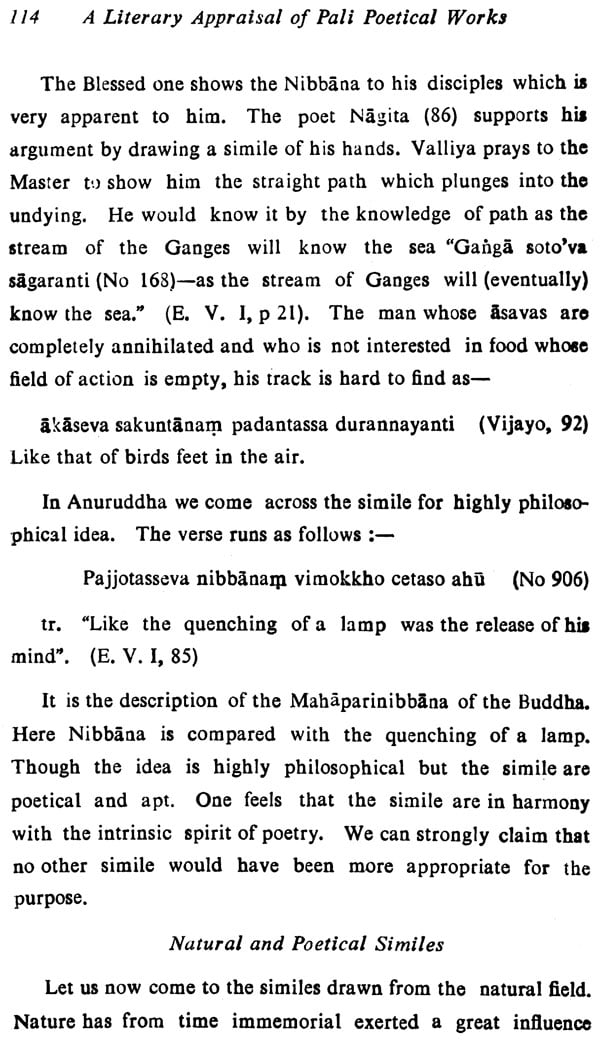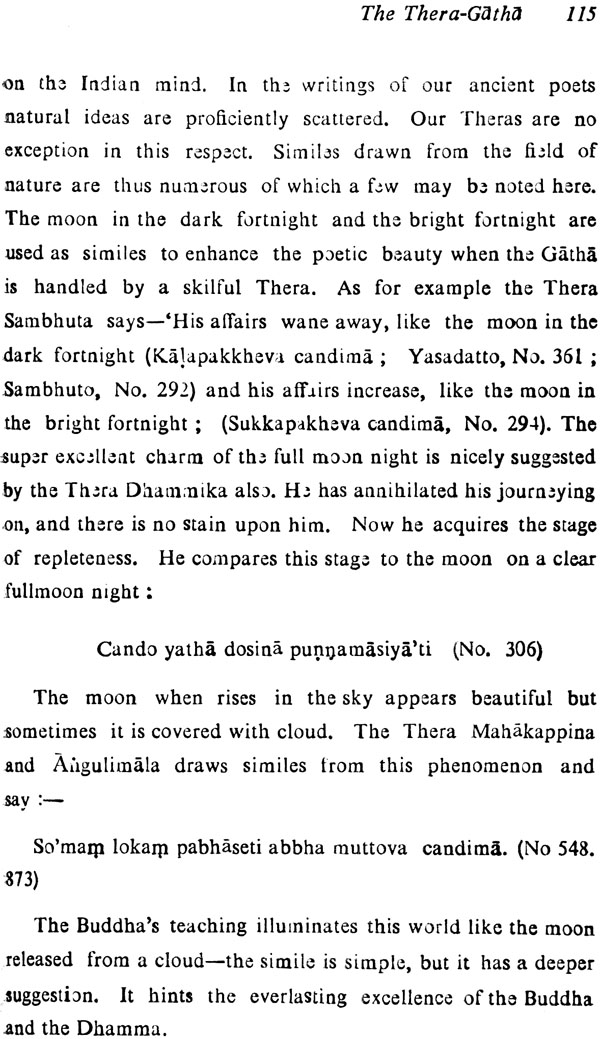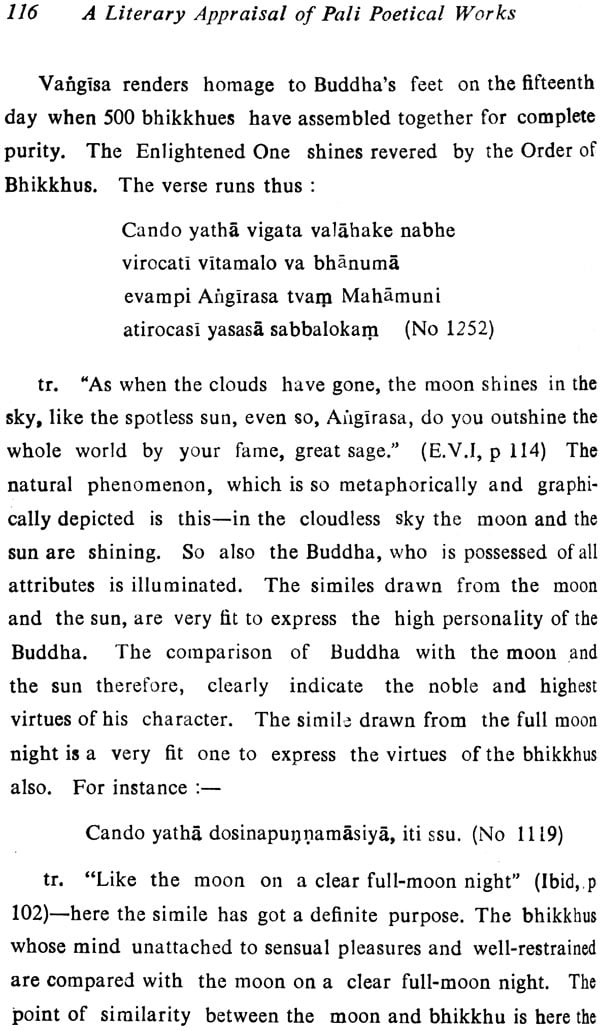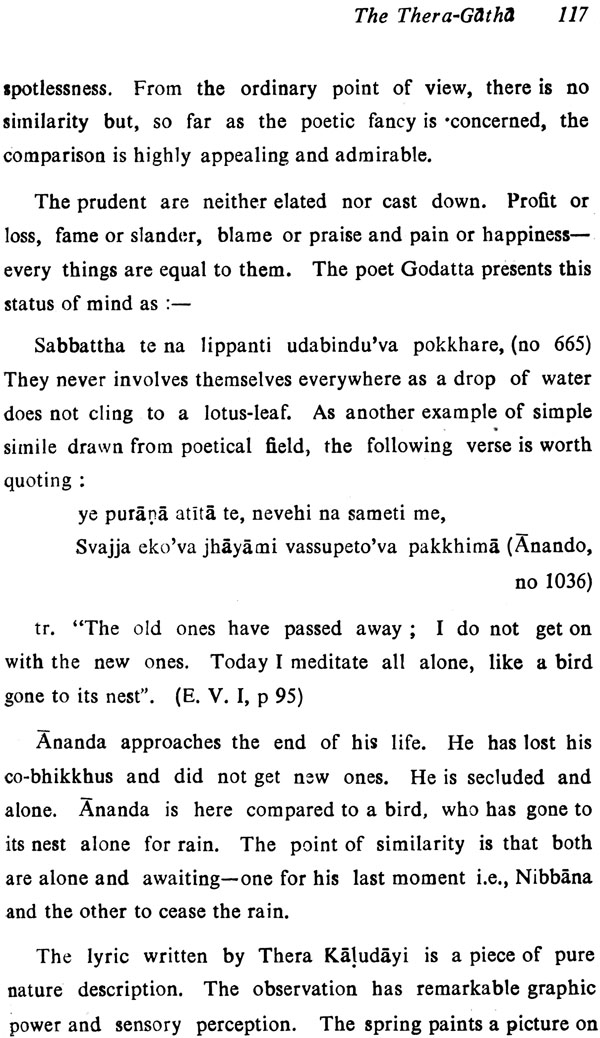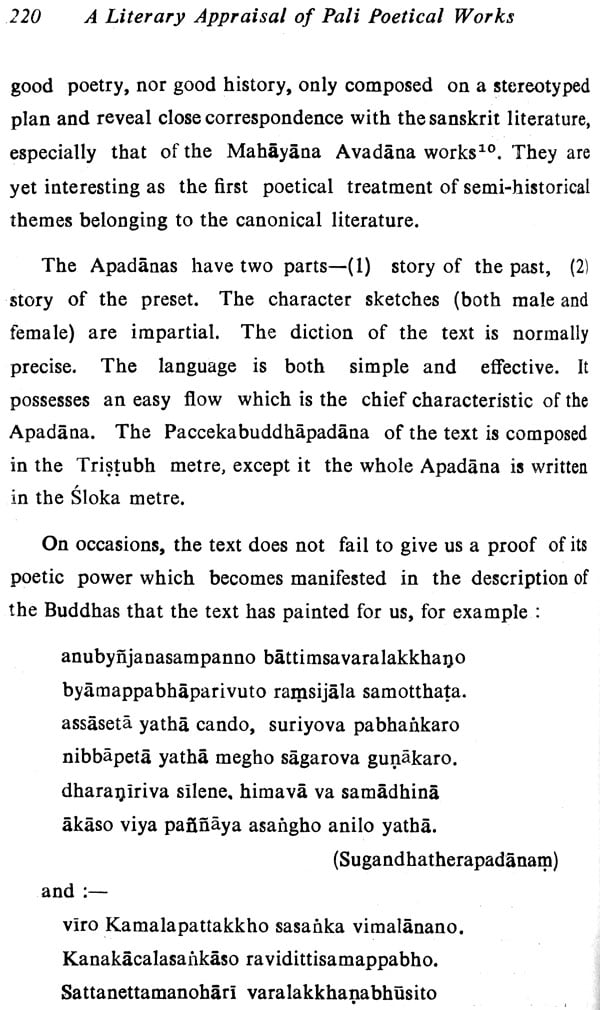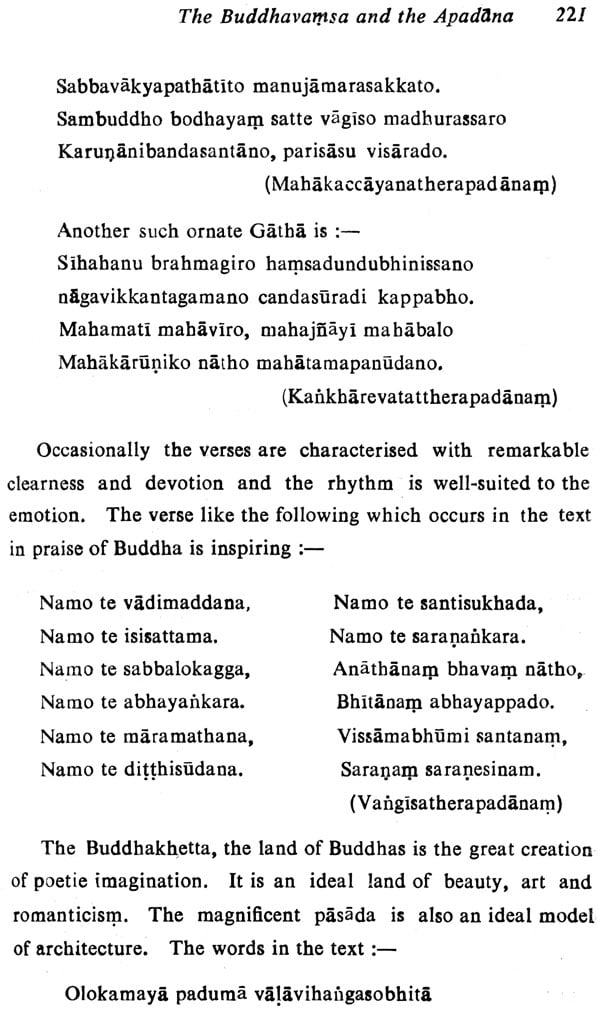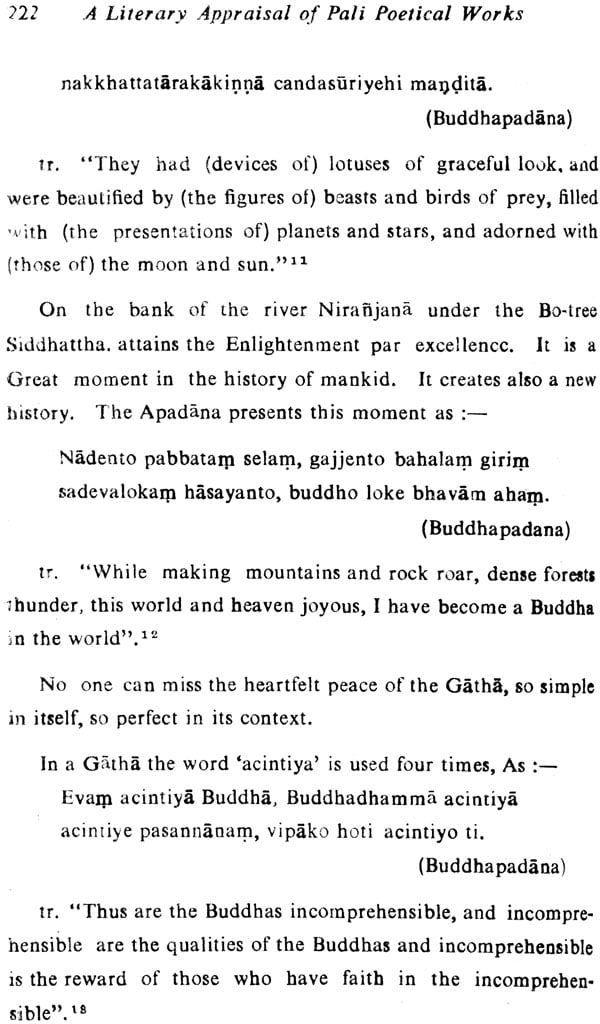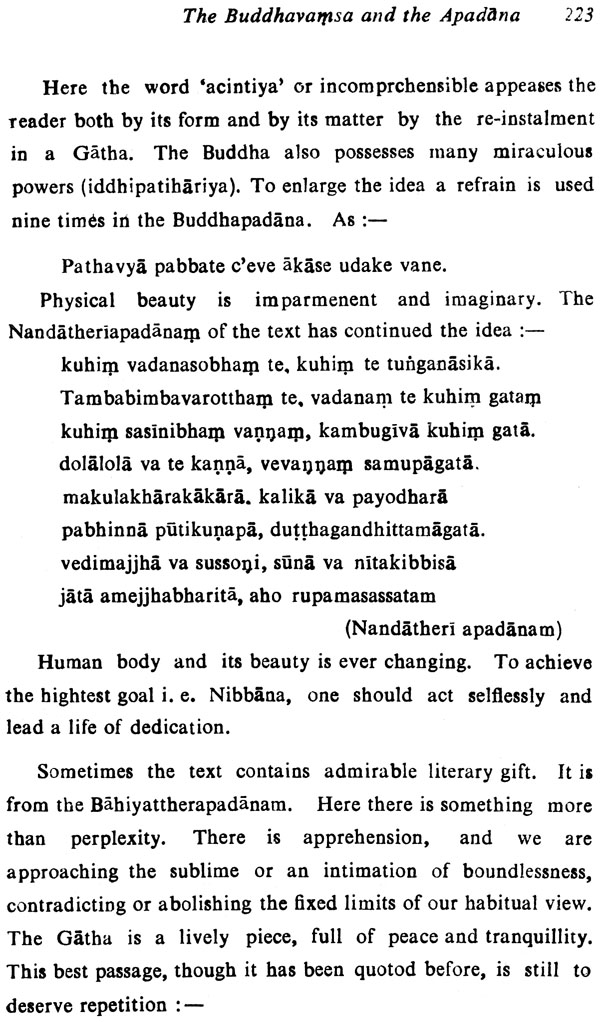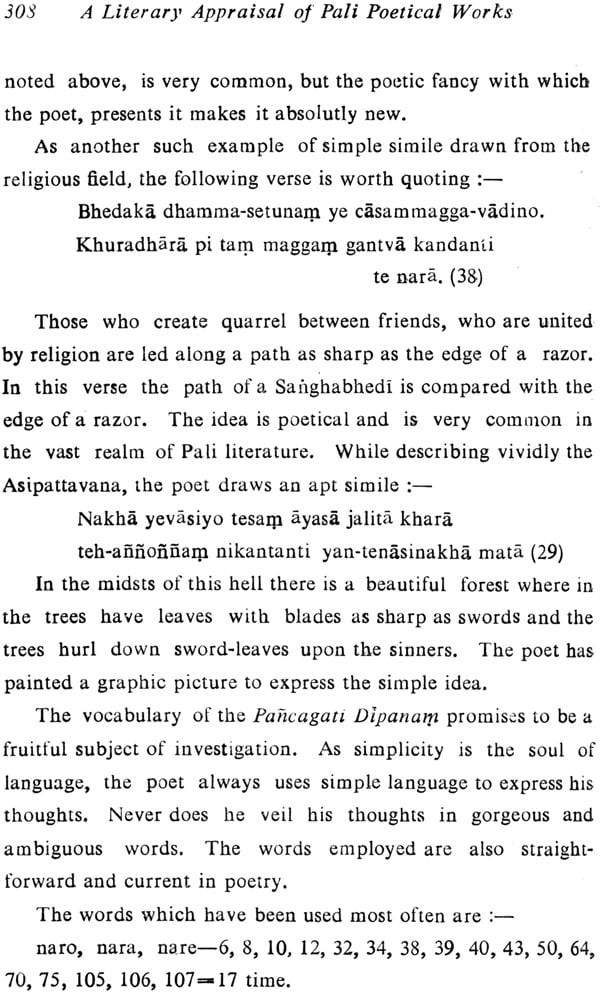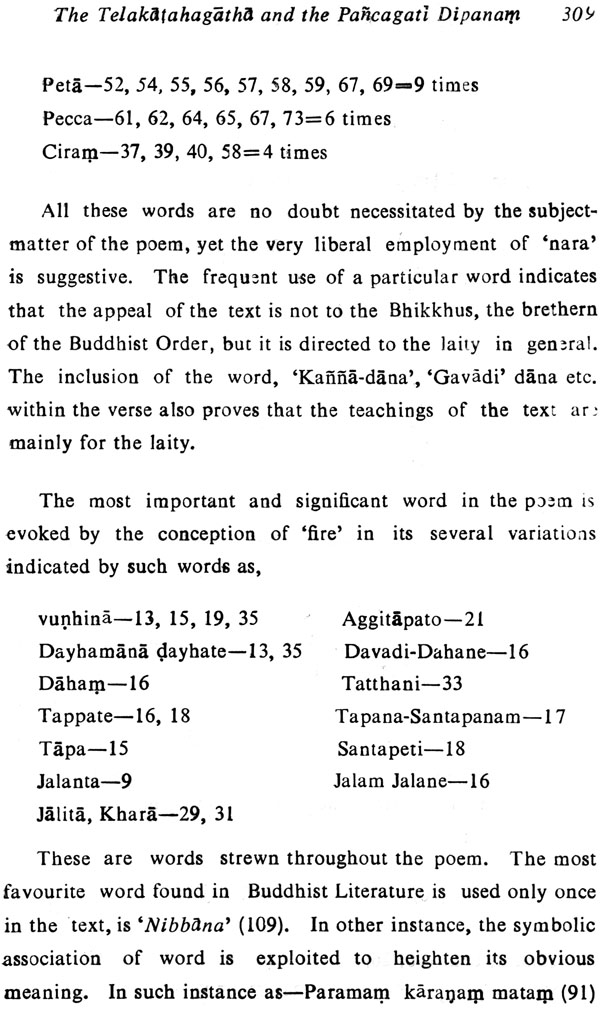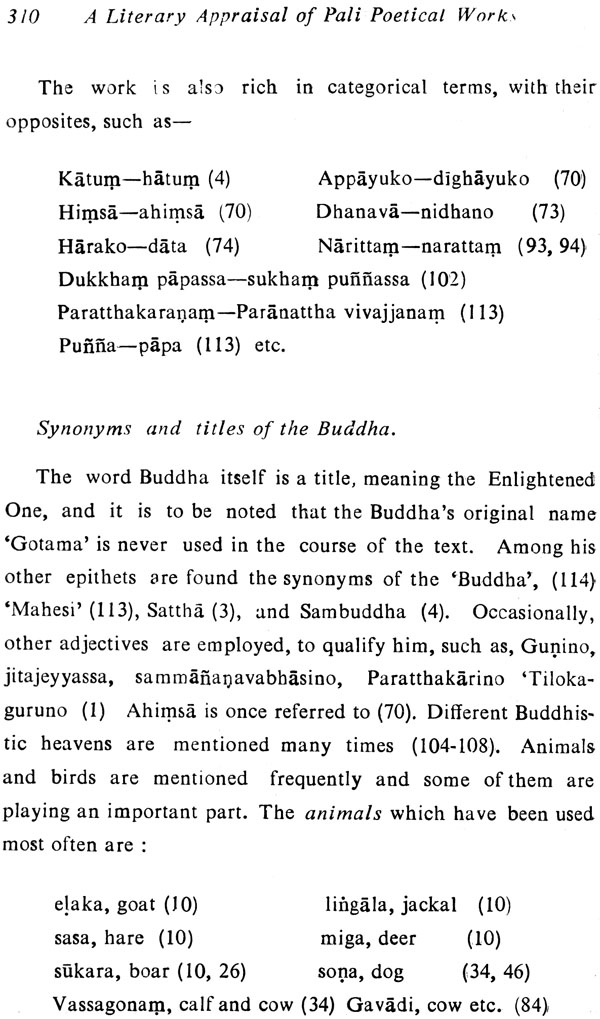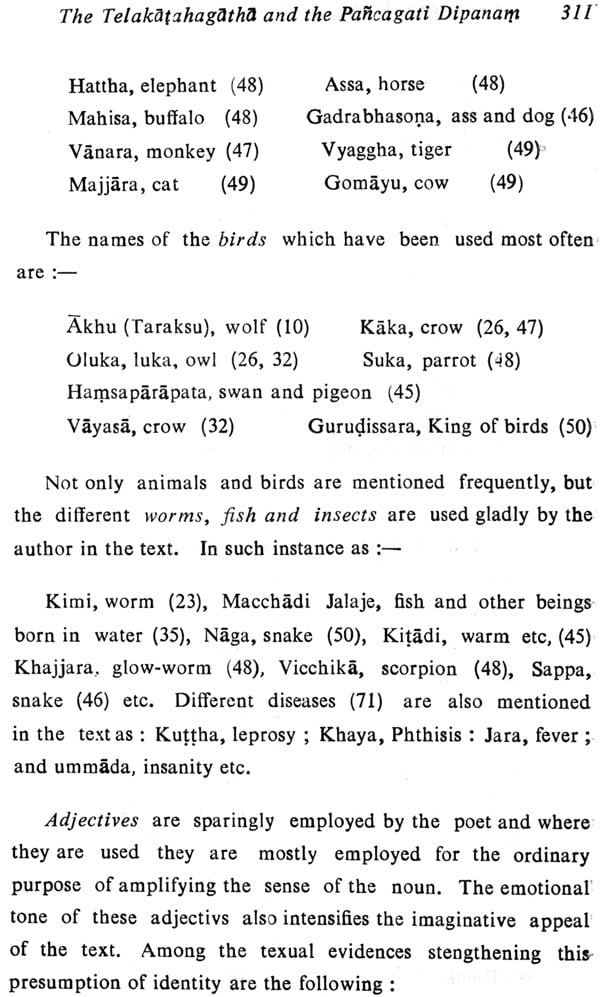
A Literary Appraisal of Pali Poetical Works (An Old and Rare Book)
Book Specification
| Item Code: | NAJ017 |
| Author: | Dr. Asha Das |
| Publisher: | PUNTHI PUSTAK |
| Language: | English |
| Edition: | 1994 |
| ISBN: | 8185094721 |
| Pages: | 344 |
| Cover: | Hardcover |
| Other Details | 8.5 inch x 5.5 inch |
| Weight | 430 gm |
Book Description
About the Book
A Literary Appraisal of Pali Poetical Works' is the first attempt of its kind and undoubtedly the most unique contribution to the field of literary. appreciation of pali poetical work. The book with nine chapters furnishes an analytical, comprehensive and critical study on the art of poetry of the twelve poetical taxts of the Khuddaka Nikaya and two other Non-canonical literary pieces. In this book, for the first time, we get true picture of literary beauty of Pall poetry and poems. It is not doubt a pionering contribution to the field of Pali literary study. This timely and authoritative work ranks among the internationally acclaimed publications of academic excellence opening a far extending vision in the field of literary estimate of Pali poetical works both canonical and non-canonical with profound feeling of gratification, the publisher marks available this book to the Indologists, Literary cities and Pali Scholars and hope that this will be a welcome addition to their collections.
About the Author
Dr. Asha Das was born in a renowned family of Chittagong (Bangladesh) which took active part in the Freedom Movement of India. Her Father Late Mahendra Kumar Das was awowedly devoted to the welfare of the country and Mother Sm. Sabitri Bala Das is always untiring to the sacred task of serving others.
At present Dr. Das is the Reader of the Department of pali, University of Calcutta. She has been awarded the prestigious Griffith Memorial Prize by the University of Calcutta for her thesis on Bauddha Dharma O Rabindranath', She obtained the Ph. D. Degree (Art) in Pali of this University for her outstanding research work on Bangla Sahitya Baaudha Dharma O Sanskrit', which was highly acclaimed by the scholars, Her books are variously prescribed by the Universities for their post-graduate and research courses. She has also contributed a great number of articles on the different aspects of Indology to several well known journals of India and abroad, Besides her academic works Dr Das is still engaged in different types of social and educational activities, Her published works till this date are: Bauddha Dharma O Rabindranath Bangla Sahitye Bauddha Dharma O Sanskriti.
Triser Sasastra Abhyutthar, Pajjamadhu-A Critical study and Ananda, the man and monk.
Preface
The present work is the outcome of my continued studies in the field of Pali poetical works both canonical and non-canonical. It is also undoubtedly a surprising fact that down to the present time, no literary criticism on Pali poems as a whole has been written in English. It is, therefore, with the greatest pleasure that I accepted my revered Acarya Dr. Sukumar Sen Gupta's suggestion to contribute a volume on the wealth of poetry in Pali literature. This appeared to me a unique opportunity for diffusing informations on a subject in which more than fifteen years of my continuous study had placed on me an ever deepening interest in Pali poetical study.
From the year 1978 to 1991, I have published some isolated articles in different oriental journals of India and abroad, such as the Journal of the Department of Pali, Calcutta University; Jagajjyoti, Calcutta; Maha Bodhi, Calcutta; World Buddhism, Sri Lanka and Kristi, Bangladesh etc. Being the first and only work of its comprehension, the subject was well appreciated everywhere and was quoted by different authorities and scholars. I was often asked by my readers to publish those articles in a book form. I have also revised considerably those published portions with fresh materials collected by more recent studies.
I am fortunate enough to have a large circle of veteran Pali scholars who helped me directly or indirectly. I acknowledge my deep debt of gratitude to my Acarya Late Professor A. C. Banerjee. I am extremely grateful also to my Professors Dr. Sukumar Sengupta, Professor Kalyan Kumar Ganguli and Professor Heramba nath Chatterjee for the interest they evinced in my works. My profound thanks are also due to Professor Dipak Kumar Barua, Head of the Department of Pali, Calcutta University, Dr. K. L. Hazra, Reader, C. U., Dr. S. C. Sarkar and Dr. S. Chaudhury, Govt. Sanskrit College; Dr. Bela Bhattacharya and Dr. Manikuntala Haidar (De), C. U. and Dr. D. N. Banerjee, Reader, Burdwan University. I am specially indebted and grateful to my elder brother Sri Phani Bhushan Das and Professor B. N. Chaudhury, Govt. Sanskrit College who constantly helped and encouraged me during the long period of my work. I offer my thanks to my students Bhikkhu B. Sumana of Sri Lanka who supplied me many Pali books on the subject and Dr. Ramesh Mukherjee, Asansol College.
I am also specially grateful to Dr. Dhrubabrata Bhattacharya. Ex-Professor of Medicine, R. G. Kar Medical College Hospital and Sri Dinesh Chandra Goswami, Ex-Head Master. Kalyannagar Multipurpose School, Rahara and Sri Jitendranath Munshi, Headmaster, Carey High School, Calcutta who offered suggestions to improve the quality of my work.
I express my gratitude to my publisher Sri S.K. Bhattacharya, Proprietor, Punthi Pustak for suggesting the appropriate title of the book, which helped me to establish my- thoughts exclusively to the literary beauty of Pali poetical works.
I shall think my humble labour in this field will be amply rewarded if I can succeed in awakening an interest in the subject in the minds of my readers and if young scholars are attracted) to take it up for further research and investigation.
I am painfully conscious of slip of numerous diacritical -marks and wrong use of capital letters at the beginning of the words in the Gathas, Many printing errors have also occurred.
I hope that my sympathetic readers will overlook the faults. With this hope I venture to present these few pages to the scholars of the literary world.
In the conclusion I like to quote a verse from the Sasana- vamsa for the readers:
"Koci etth'eva doso ca pannayati sucittaka
Tam khamantu ca sudhira ganhantu yuttikam have ti.”
Tr. "If any defect is found here, let those of good hearts -excuse it, and let those who are well-considerate accept what may be. reasonable."
Introduction
The literature of the Pali language, rich in original beauty, is really most extensive whose great importance is ever known to the world. Literary production both Canonical and Non-Canonical, taken together is innumerable in Pali. Some of these poetical texts, we are all agreed, are the gems in Pali literature. Here I have tried to discuss, at some length only those books of the Khuddakanikilya which are written in verse. They are ;-
(1) The Suttanipata (2) The Dhammapada (3) The Theragatha (4) The Therigatha (5) The Udana (6) The Itivuttaka (7) The Khuddakapatha (8) The Cariya Pitaka (9) The Vimanavatthu (10) The Petavatthu (11) The Buddhavamsa (12) The Apadana etc. These poetical texts have a place all their own among the literary works of Pali and they have no equal with regard to the extent and profundity of their influence on the later Pali texts. In nobility of theme, depth of thought and sound pattern they have set a standard for later Pali works to follow. The contributors of these poetical works, may be either Gotama the Buddha or his devout followers, they are at once a philosopher, and a poet. Therefore, their works are borne out by the wealth of wisdom and the sensory perception they possess. The later Pali poetical works, the Anagatavamsa, the Jinacarita, the Telakatahagatha, the Pajjamadhu display the literary excellence and poetical imagination. Here, the texts with which I am concerned are the Telakatahagatha and Pancagati Dipanam. The Pali literature has also multifarious interest. The great insight into life and environment and social reality are depicted here in magnitude and complexity. It is of value alike to the student of folk-lore and of comparative religion. Fortunately, there is no lack of authentic history of Buddhism. Linguistic and philosophical studies have been more or less vigorously discussed in Europe and Asia. But uptil now no systematic literary critism of the Pali texts has appeared and for the purpose there is a great want felt by the scholars who are working in this field. Thus there is a gap in our knowledge of Pali literary criticism. I, have therefore, attempted for the first time to fulfil this long expected need of the literary approach, to some Canonical literature. My humble intention is to bring out a complete and all embracing literary criticism of the Canonical Pali poetry and to open a new path for the future which I consider essential for grasping the significance of these works. The works with which our standard literary criticism of Pali texts deal are almost exclusively confined to some articles only. The reader will have to feel grateful to Mrs Rhys Davids. Her charming study is 'Similies in the Nikayas." It is a matter of joy also to write that Prof. Bapat in his Suttanipata has been able to produce a grand Introduction in which the language, style and versification of the text are discussed clearly. The editor of the Khuddakanikaya Vol. VI. and VII. dealt with the lists of similes or upamayo in detail." These writings more or less appeal to the specialists or readers, but these are not complete and detailed literary criticism of the texts. My treatment of the subject is the wealth of poetry which is entirely different from those of my predecessors.
It is not beyond the scope of this inquiry to enter into a discussion of the poet and the poetry. The poet is a teacher, a moralist and his function is to make men better. He is a possessed man, not using language in the way that normal human beings do, but speaking in a inspired paroxysm. The poetry is the sponteneous over flow of powerful feelings and emotion. Therefore, the poetry is the union of deep feeling and profound thought. It is not merely an ingenious game of words, it is not only science or history or philosophy, but some thing more. "Poetic imagination is that gift of mind by whose aid one can visualise myrial things anew”-Dhvyanyalokalocana, Abhinavagupta.
cf. Prajna navanavonmesasalini pratibha mata /
Tadanuprananajivadvarnananipunah Kavih //
Tasy karma smrtam kavyam.
It is by virtue of this gift alone that one deserves the title of 'Poet." He is superior as a moral teacher to both historian and philosopher. He does not deal with more abstract problem or prediction as philosophy does. It is not a systematic account of the origin and progress of an event.
Contents
| Preface | ix-xi | |
| Introduction | Jan-21 | |
| Chapter-1 | The Dharnmapada | 22-49' |
| Chapter-2 | The Suttanipata | 50-96 |
| Chapter-3 | The Theragatha | 97-144 |
| Chapter-4 | The Therigiithii | 145-169 |
| Chapter-5 | The Udana and the Itivuttaka | 170-191 |
| Chapter-6 | The Buddhavarpsa and the Apadana | 198-236 |
| Chapter-7 | The Vimiinavatthu and the Petavatthu | 237-268 |
| Chapter-8 | The Khuddakapatha and the Cariyapitaka | 269-283 |
| Chapter-9 | The Telakatahagatha and the Pancagati Dipanam | 284-316 |
| Bibliography | 317-323 | |
| Additions and Corrections | 325-326 | |
| Index | 327-331 |
